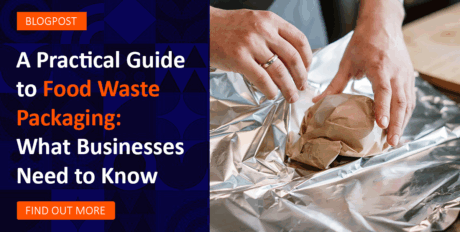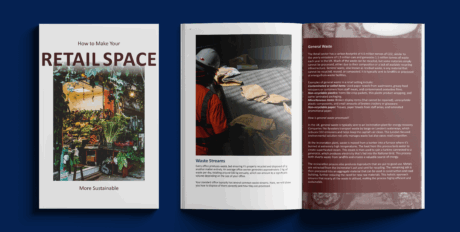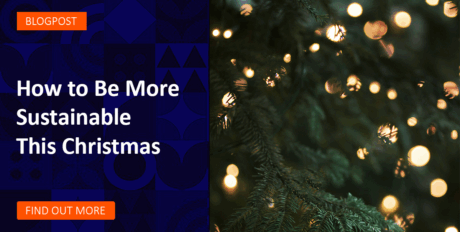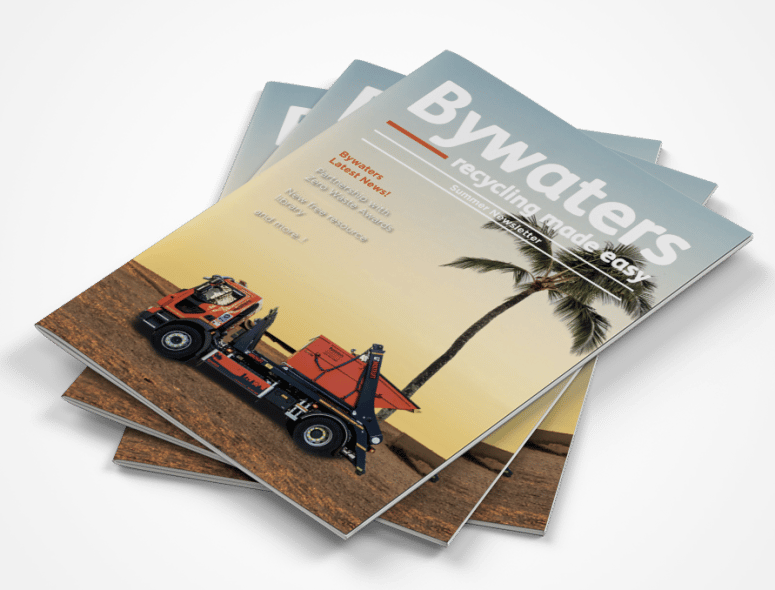Contact us today for your Free Quote
Did you know your Halloween fun comes with a terrifying environmental cost?
Halloween is a massive celebration throughout the UK. UK consumers spent an estimated £776 million on the holiday in 2024, and the market continues to grow. But with all that excitement and spending comes an enormous amount of consumption, and with it, a lot of waste.
Whether it’s this year’s plastic-packed costume or the jack-o’-lantern you’ll toss next week, many items purchased for the holiday are thrown away almost immediately. This “use-it-once” habit is the very definition of poor resource management, making Halloween an environmental nightmare.
We don’t think celebrating should mean sacrificing the planet. That’s why we’ve put together our ultimate guide for a more sustainable Halloween, focusing on the top priorities of the waste hierarchy: Refuse, Reduce, and Reuse, to help you spook away without leaving a scary impact.
What is the Waste hierarchy
The Waste Hierarchy is a fundamental concept in environmental management, often represented as an inverted pyramid. It ranks waste management options according to what is best for the environment, guiding us toward the most resource-efficient choices.
Here’s how the hierarchy is prioritised, from best to worst:
- Prevention/Refuse: The most preferred option. It means avoiding waste in the first place (e.g., refusing unnecessary packaging or single-use items).
- Reduce: Decreasing the quantity of materials you consume.
- Reuse: Giving products a second life, whether for their original purpose or a new one (e.g., passing on costumes).
- Recycle: Processing waste materials into new products.
- Recovery/Disposal: The least preferred options, such as incineration for energy recovery or, worst of all, sending waste to landfill or incineration.
This holiday, our guide focuses on the vital top three steps, Refuse, Reduce, and Reuse to help you spook away without leaving a scary impact!
Refuse
In the waste hierarchy, refusing unnecessary consumption is the most impactful step you can take. Most of the UK’s Halloween waste comes from cheap items designed to be used once and thrown away. The numbers speak for themselves: UK consumers spent an estimated £374 million on Halloween costumes, decorations, and accessories in 2023, the very items often destined for the bin.
We challenge you to just say no to these items this year.
How to Refuse this Halloween
- Refuse to Buy New, Cheap Costumes: The vast majority of novelty costumes are made from non-recyclable plastic fabrics and will end up in landfill and being incinerated after one night. Commit to buying nothing new for your outfit.
- Refuse Single-Use Decor: Skip the plastic cobwebs, disposable streamers, and flimsy banners that break easily. These often cannot be recycled and only add to the waste problem.
- Refuse The Plastic Tat: Say no to cheap plastic toys, party favours, and small accessories that guests or trick-or-treaters will immediately discard. If a party bag item is destined for the bin before November, refuse to buy it.
- Refuse Excess Packaging: When stocking up on treats or supplies, consciously select products with minimal or recyclable packaging. Better yet, seek out zero-waste stores that allow you to fill your own reusable containers
Reduce
If you can’t outright Refuse an item, the next most important step in the waste hierarchy is to Reduce the quantity or environmental impact of what you buy. This means actively planning to minimise the amount of material waste you generate, long before your Halloween event even begins.
How to Reduce this Halloween
- Minimise Food Waste: Halloween parties are notorious for mountains of uneaten snacks and treats. The UK spent over £1 billion on Halloween confectionery in 2023, a significant portion of this expenditure often contributes to waste. Plan your catering precisely to reduce the amount you buy by estimating servings carefully.
- Downsize Decorations: If you traditionally buy five bags of novelty items, reduce it to one bag of higher-quality, durable decorations you can use year after year. Every item you don’t buy means less waste and less demand for virgin materials.
- Reduce Energy Consumption: If your display involves lights, timers are your friend. Reduce the amount of electricity you use by setting lights to switch off automatically after a certain hour or by switching to energy-efficient LED bulbs.
- Choose Smaller, Reusable Packaging: When you must buy treats, consciously select larger multi-packs or loose sweets where possible, rather than individually wrapped small bags. This reduces the volume of wrapper plastic going into your bin.
- Use Less Print: If you’re sending out invitations, reduce your paper consumption by opting for digital invites instead of printed flyers or cards.
Reuse
When you can’t Refuse or Reduce, the next powerful action is to Reuse. This means extending the life of products by using them again, either for their original purpose or by creatively repurposing them. Reusing saves resources that would otherwise be used to manufacture a new item and diverts perfectly good materials from landfill.
How to Reuse this Halloween
- Instead of buying a new outfit: reuse last year’s costumes, swap with friends, or look to your own wardrobe for creative DIY solutions. A little bit of makeup and some clever accessories can transform everyday clothes into a spooky spectacle.
- Don’t let your jack-o’-lantern become needless food waste! We encourage you to reuse the flesh and seeds to give your pumpkin a second life. You can roast the seeds for a tasty snack and use the sweet flesh for comforting autumn meals like soups, curries, or baking. Once the festive display is finally over, make sure the remaining shell is disposed of responsibly: compost it (if facilities are available in your area) or safely offer it to local wildlife. We’ve even created a bunch of brilliant recipes you can use to make sure absolutely nothing goes to waste.
- Repurpose Household Items for Decor: Get creative with materials you already have. Old bedsheets make fantastic spooky ghosts, cardboard boxes can be reused to create tombstones, and glass jars can be washed and decorated to become lanterns.
- Host a Decorations Swap: Before buying new accessories, reuse items from your social circle. Organise a simple swap meet with friends or neighbours to trade decorations and costumes that have been used for just one season.
- Donate, Don’t Discard: If you have costumes or decorations you know you won’t use again, reuse them by donating them to a local charity shop like one of our partners traid or school drama club, giving them a second life and preventing them from becoming waste.
Recycle
In the waste hierarchy, Recycling is a valuable process, but it requires energy, water, and resources, which is why it sits below Refuse, Reduce, and Reuse. It should be the final option for materials that truly cannot be used again. This step ensures that materials are reprocessed into new products rather than being sent to landfill.
How to Recycle this Halloween
- Check Your Pumpkin Waste: Once you have Reused the pumpkin flesh and seeds, and the shell is past its best, ensure it goes into the correct waste stream. If your local authority provides a food waste collection or composting service, use it! Never put pumpkins into your general waste bin.
- Be Smart with Sweet Wrappers: Many local council services cannot process soft, crinkly plastics (like crisp packets or some sweet wrappers). Check if your local supermarket offers a recycling drop-off point for these flexible plastics. Avoid “wish-cycling” (putting non-recyclable items into the recycling bin) as this contaminates the entire batch.
- Recycle Packaging Properly: Any card, paper, or hard plastic packaging from your treats or decorations should be recycled. Ensure all items are clean, dry, and flat (for cardboard) before placing them in your household recycling bin. Remove any residual food or contamination.
- Avoid Recycling Flimsy Costumes: Remember, almost all cheap, single-use fancy dress costumes are made of synthetic fibres (like polyester or nylon). These are textile waste, not plastic packaging, and should not go into your normal household recycling bin. If you can’t donate them, they unfortunately belong in the general waste.
Recovery
At the very bottom of the Waste Hierarchy are Recovery and Disposal. These options are the least favourable because they represent the greatest loss of resources and the biggest impact on the environment. Recovery (usually energy from waste) is better than direct Disposal (landfill), but our goal is always to keep materials out of these streams entirely.
Avoiding the Bottom of the Pyramid
- Residual Waste is the Last Resort: Only items that truly cannot be refused, reduced, reused, or recycled should ever go into your general waste bin, which is destined for recovery or landfill. If you have followed the first four steps of this guide, your residual waste should be minimal!
- The Cost of Disposal: Remember that once an item hits landfill, its useful life is over, and it can take hundreds of years to break down, often releasing harmful greenhouse gases in the process.
A Sustainable Halloween Awaits
Halloween doesn’t have to be an environmental horror show. By consciously moving your consumption up the Waste Hierarchy, starting with Refuse and ending with smart Recycling, you take control of your impact.
This year, challenge yourself and your family to prioritise a spooky celebration that’s kind to the planet. We’ve given you the tools now go ahead and enjoy.
If you are a commercial business or property is looking to be more responsible this Halloween and year-round, we at Bywaters can support your organisation. We help implement every step of the waste hierarchy from reducing consumption to optimising your recycling and recovery processes, ensuring your operation is responsible to the environment.
More posts:
A Practical Guide to Food Waste Packaging: What Businesses Need to Know
Food packaging plays a major role in workplace waste, but not everything that looks recyclable actually is. This guide explains how different packaging materials behave in the waste system, how contamination affects recycling, and what businesses can do to make smarter, more sustainable choices.
Read moreThe Ultimate Guide For a Sustainable Retail Space
Download The Ultimate Guide For a Sustainable Retail Space. Get the roadmap to cut costs, reduce your carbon footprint, and boost your ESG profile with 5 core pillars.
Read moreHow to Be More Sustainable This Christmas
Christmas is one of the most waste-intensive seasons in the UK, but small changes can make a big difference. This guide explores practical ways to make your celebrations more sustainable, from eco friendly wrapping and decorations to reducing food waste, choosing greener travel options and improving workplace sustainability.
Read more




